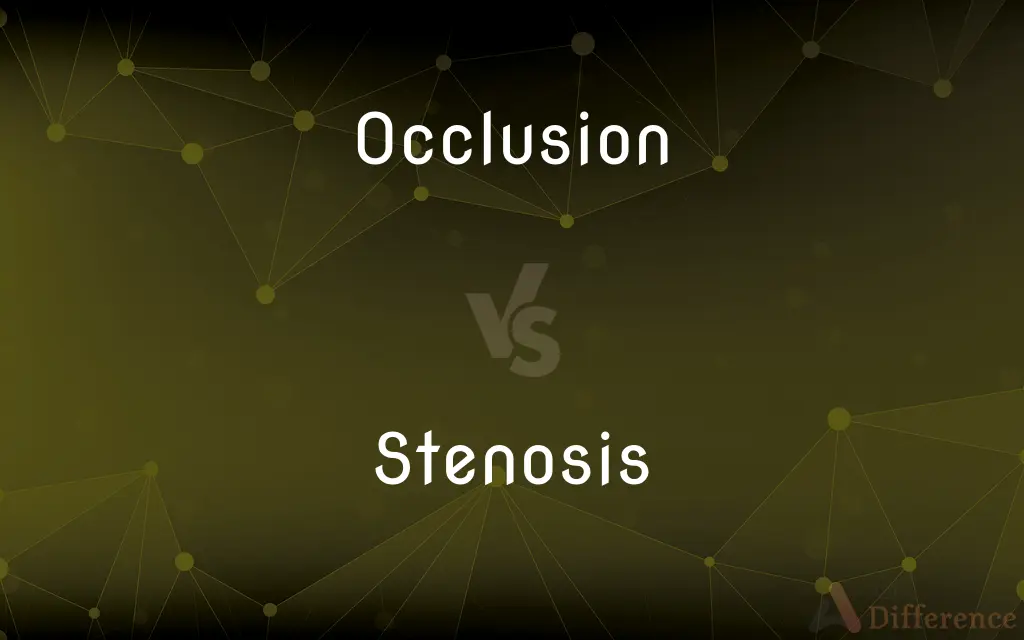Occlusion vs. Stenosis — What's the Difference?
Edited by Tayyaba Rehman — By Fiza Rafique — Updated on April 29, 2024
Occlusion refers to the complete blockage of a passage or opening, whereas stenosis describes a partial narrowing of these structures.

Difference Between Occlusion and Stenosis
Table of Contents
ADVERTISEMENT
Key Differences
Occlusion involves the total closure or blockage of a channel, such as an artery or a tube in the body, often resulting in the complete stoppage of flow through that passage. On the other hand, stenosis is characterized by a partial narrowing, which restricts but does not completely halt the flow through the affected passage. This distinction is critical in medical contexts, affecting treatment choices and prognoses.
In occlusion, the blockage can be caused by various factors such as thrombosis, embolism, or external compression. Whereas, stenosis often results from long-term processes like calcification, chronic inflammation, or congenital abnormalities, leading to gradual onset of symptoms.
The consequences of occlusion are typically more severe and sudden, presenting as emergencies that require immediate medical attention. Conversely, stenosis may develop symptoms gradually, allowing for more time to diagnose and manage the condition before it becomes critical.
Diagnostic approaches for occlusion often involve imaging techniques that can visualize blockages, such as angiography or ultrasound. In contrast, stenosis may be evaluated using similar methods, but the focus is on measuring the degree of narrowing and its impact on flow dynamics.
Treatment for occlusion may include interventions to immediately remove or bypass the blockage, such as surgical procedures or the use of thrombolytics. Stenosis, however, might be managed with lifestyle changes, medications to control the underlying causes, or interventions to widen the narrowed area, like angioplasty.
ADVERTISEMENT
Comparison Chart
Definition
Complete blockage of a passage.
Partial narrowing of a passage.
Causes
Thrombosis, embolism, external pressure
Calcification, inflammation, genetics
Symptom Onset
Sudden
Gradual
Diagnostic Techniques
Angiography, ultrasound
Angiography, ultrasound, flow studies
Treatment Options
Surgical removal, thrombolytics
Lifestyle changes, angioplasty
Compare with Definitions
Occlusion
The act of blocking or closing off a space.
The occlusion of old mine shafts prevents accidents.
Stenosis
A reduction in the diameter of a canal or duct.
Pulmonary stenosis affects the lung arteries.
Occlusion
A complete obstruction within a vessel.
A blood clot can cause an occlusion in an artery.
Stenosis
Partial constriction of a biological passage.
Spinal stenosis can lead to nerve pain.
Occlusion
The blockage of a biological passage.
The occlusion of the bile duct was complete.
Stenosis
The process of becoming narrower.
The stenosis of the water pipe affected the flow rate.
Occlusion
A condition where no medium can pass.
An occlusion in the sewer line required urgent repairs.
Stenosis
A narrowing condition affecting tubes or vessels.
Aortic stenosis is a serious heart condition.
Occlusion
Total closure of a pathway.
The occlusion of her windpipe was a medical emergency.
Stenosis
A chronic condition causing gradual narrowing.
Arterial stenosis can lead to decreased blood flow.
Occlusion
A process by which the cold front of a rotating low-pressure system catches up the warm front, so that the warm air between them is forced upwards off the earth's surface between wedges of cold air.
Stenosis
A constriction or narrowing of a duct or passage; a stricture.
Occlusion
The position of the teeth when the jaws are closed.
Stenosis
A reduction in either mental or physical capacity.
Occlusion
The process of occluding.
Stenosis
A narrowing of the opening or hollow of any passage, tube, or orifice; as, stenosis of the pylorus. It differs from stricture in being applied especially to diffused rather than localized contractions, and in always indicating an origin organic and not spasmodic.
Occlusion
Something that occludes.
Stenosis
Abnormal narrowing of a bodily canal or passageway
Occlusion
(Medicine) An obstruction of an anatomical passage, as of an artery by plaque.
Occlusion
(Dentistry) The alignment of the teeth of the upper and lower jaws when brought together.
Occlusion
The process of occluding air masses.
Occlusion
An occluded front.
Occlusion
(Linguistics) Closure at some point in the vocal tract that blocks the flow of air in the production of an oral or nasal stop.
Occlusion
The process of occluding, or something that occludes.
Occlusion
(medicine) Anything that obstructs or closes a vessel or canal.
Occlusion
The alignment of the teeth when upper and lower jaws are brought together.
Occlusion
(meteorology) An occluded front.
Occlusion
(phonetics) A closure within the vocal tract that produces an oral stop or nasal stop.
Occlusion
(physics) The absorption of a gas or liquid by a substance such as a metal.
Occlusion
(computing) The blocking of the view of part of an image by another.
Occlusion
The act of occluding, or the state of being occluded.
Constriction and occlusion of the orifice.
Occlusion
The transient approximation of the edges of a natural opening; imperforation.
Occlusion
(meteorology) a composite front when colder air surrounds a mass of warm air and forces it aloft
Occlusion
(dentistry) the normal spatial relation of the teeth when the jaws are closed
Occlusion
An obstruction in a pipe or tube;
We had to call a plumber to clear out the blockage in the drainpipe
Occlusion
The act of blocking
Common Curiosities
What are common causes of occlusion?
Occlusion can be caused by thrombosis, embolisms, or physical compression.
What is stenosis?
Stenosis refers to the partial narrowing of a passage or opening.
What is an occlusion?
An occlusion is a complete closure or blockage in a passage or opening.
What are common causes of stenosis?
Stenosis may result from processes like calcification, chronic inflammation, or congenital conditions.
What treatments are available for occlusion?
Treatments for occlusion may include surgical interventions or medications like thrombolytics.
How do occlusion and stenosis differ in symptom onset?
Occlusion often leads to sudden symptoms, whereas stenosis causes symptoms that develop gradually.
How is occlusion diagnosed?
Occlusion is typically diagnosed using imaging techniques like angiography or ultrasound.
Can stenosis be reversed?
Some forms of stenosis can be improved with treatment, though it often requires ongoing management.
Are there any preventive measures for occlusion?
Preventive measures include managing risk factors like high cholesterol and avoiding smoking.
Is occlusion more serious than stenosis?
Occlusion is generally more immediately serious and life-threatening than stenosis.
What treatments are available for stenosis?
Stenosis can be managed with lifestyle modifications, medications, or procedures like angioplasty to widen the passage.
How is stenosis diagnosed?
Stenosis is diagnosed through similar imaging techniques, often focused on measuring flow restriction.
Can occlusion lead to permanent damage?
Yes, if not treated promptly, occlusion can cause permanent damage due to the lack of flow.
What are the long-term effects of untreated stenosis?
Untreated stenosis can lead to significant complications, including impaired function of affected organs or structures.
Can lifestyle changes prevent stenosis?
Yes, lifestyle changes like diet and exercise can help manage and possibly prevent some types of stenosis.
Share Your Discovery

Previous Comparison
Lilac vs. Violet
Next Comparison
Communism vs. BolshevismAuthor Spotlight
Written by
Fiza RafiqueFiza Rafique is a skilled content writer at AskDifference.com, where she meticulously refines and enhances written pieces. Drawing from her vast editorial expertise, Fiza ensures clarity, accuracy, and precision in every article. Passionate about language, she continually seeks to elevate the quality of content for readers worldwide.
Edited by
Tayyaba RehmanTayyaba Rehman is a distinguished writer, currently serving as a primary contributor to askdifference.com. As a researcher in semantics and etymology, Tayyaba's passion for the complexity of languages and their distinctions has found a perfect home on the platform. Tayyaba delves into the intricacies of language, distinguishing between commonly confused words and phrases, thereby providing clarity for readers worldwide.
















































